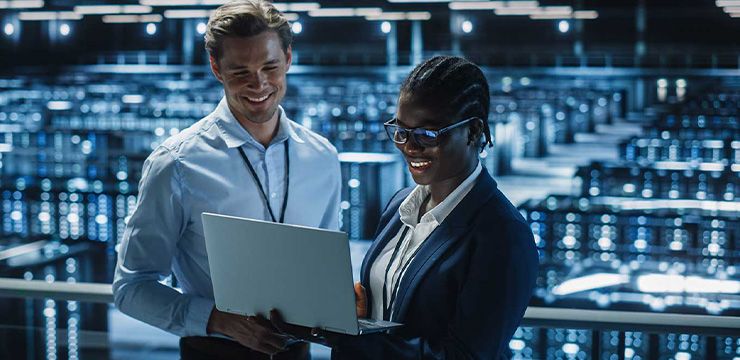What is Data Analytics? What is its Significance in Business?

A 2021 Forbes report states that over 70 per cent of IT decision-makers find it difficult to trust their organizational data. While businesses have attained high levels of data accessibility, how do they use digital data to its highest potential? That’s where it is important to understand the role played by data analytics. This guide deals with all the critical questions on data analytics, including what is data analytics, what are its different types and what average salary packages can professionals expect to make. Read on to find out more.
What is Data Analytics?
Data analytics is the science behind filtering raw data to identify patterns that can be used across different businesses. It deploys multidimensional tools to gather, organize and interpret insights that enable organizations to make informed decisions. Today, almost every industry leverages data analytics to shape strategic thinking. From major healthcare analytics to local community interventions that fight climate change, the applications of data analytics are far-reaching and diverse. The field of analytics thrives on a network of collaborations, from setting up the correct analytical system to the final visualization of the analyzed information.
Why is Data Analytics Important?
The importance of data analytics is widespread and touches different industries in different ways. For instance, it optimizes manufacturing mechanisms and savings on resources, maximizes productivity by planning efficient workflows, and creates meticulous data structures to strengthen cloud security systems. We have seen how Tesla assimilated its sensor data with autonomous driving technology to improve navigation and design accurate maps. Research giants such as DeepMind deploy machine learning and analytics to find futuristic solutions to contemporary problems. In the world of sales and marketing, data analytics equips managers to identify patterns in buying behaviors, satisfaction levels, and user queries to tailor their products and services. Thus, irrespective of the industry a data scientist belongs to, they are helping shape strategy in definitive ways.
ALSO READ: What is Big Data? Let’s Analyze its Rise and Implications
What are the Types of Data Analytics?
Now that you have an idea of what is data analytics, let’s get into its various types. These include:
1. Descriptive Analytics
Descriptive analytics mines historical data to understand the relationship between past events and the present conditions of the organization. It is one of the most widely used analytical tools favored by marketing, finance, sales, and operations teams, as it efficiently looks into past data and provides an analysis of the changes by comparing patterns and trends. Applications of descriptive analytics include data queries of Business Intelligence (BI) and financial metrics such as growth in overall sales, revenue per subscriber, number of users, and month-over-month sales growth.
2. Diagnostic Analytics
Diagnostic analytics helps figure out why something happened the way it did. It deploys hypothesis testing, data drilling, and data mining to understand the relationship between variables. Single linear regression and multivariate regression help scientists make impactful predictions by distinguishing cause and correlated variables. Although regression analysis studies past behaviors, these data patterns can also be repurposed to suit the company’s needs in the near future.
Real-life applications of diagnostic analytics comprise detailed visual explanations of current market demand, consumer behavior, or human resources issues such as improving company culture.
3. Predictive Analytics
This is the third level of data analytics that mixes historical data with a wide range of statistical models to predict future trends and business outcomes. Algorithms deploy three common techniques for this kind of analysis: decision trees, regression analysis, and neural networks. Predictive analytics often forms the lifeblood of organizations in different industries. Fintech companies determine their future cash flows and acquire a detailed view of their financial health. In the entertainment industry, it helps gauge the relationship between consumer choices and future marketing campaigns.
4. Prescriptive Analytics
A prescriptive analysis synthesizes the conclusions drawn from the three previous forms of analytics. It determines optimal courses of action and recommends beneficial steps to serve the evolving consumer needs. Prescriptive analytics typically draws its conclusions from Machine Learning (ML), heuristics, and certain rule-based systems.
ALSO READ: How to Learn Data Science: Is it Still All the Rage in 2022?
The Role of Data Analytics
To have an in-depth practical knowledge of what is data analytics, a working knowledge of the processes of filtering and cleaning unorganized data is vital. While every other industry is harnessing the immense potential of this resource, data analytics plays a key role in the following ways:
- Improved analysis of information trends
- More utilitarian and customer-centric products
- Promotion of sustainability and smart energy usage
- Efficient marketing campaigns
- Sophistication in cyber-security ventures
- Streamlining of manufacturing operations
- Foresight and mitigation of business risks
- Improved insurance health and smart saving plans
- Creation of refined prediction systems and personalized healthcare for the general public
Popular Data Analytics Tools
Understanding what is data analytics is incomplete without also exploring the tools that enable it. These include:
- Programming languages such as Python and R
- Data wrangling tools like Alterix and Cambridge Semantics
- Comprehensive analytical packages, including IBM SPSS and SAS Institute Inc
- Machine learning tools such as Microsoft’s PowerBI and Oracle Analytics
- Natural Language Processing (NLP) tools (ThoughtSpot and TIBCO Spotfire, for example)
- Automated data preparation software systems like IBM Cognos
- Collaboration and code-sharing tools such as Jupyter Notebook and Deepnote
- Data visualization tools ( D3.js and DevExpress, for example)
ALSO READ: How to Become a Data Analyst and Help Draw Insights for Businesses
Career Outlook for Data Analytics Professionals
A BLS report predicts that the sectors of data analytics and data science will witness a 36 per cent growth in employment. At the same time, the 2021 McKinsey Global Survey found that 56 per cent of industries worldwide have shifted to AI in at least one wing of their entire production chain. Most simulations mark this progress to project a 70 per cent rise in industries adopting complete automation by 2030, making business functions a hotbed for data scientists.
Average Salary for Data Analytics Professionals
Integrating traditional business models with new-age data analytics attracts very impressive pay scales. A Glassdoor review indicates an average annual salary of $92,697 in data analytics in the US, while the range varies between $78,000 to $146,000.
Grow your Data Analytics Career with Emeritus
Data has established itself not only as a most profitable resource but also as a promising career for professionals inclined towards analytics and numbers. Become more competitive and leverage the growth potential of this field by taking on the data sciences and analytics courses on Emeritus, which will prepare you for many upcoming challenges.
By Bishwadeep Mitra
Write to us at content@emeritus.org





